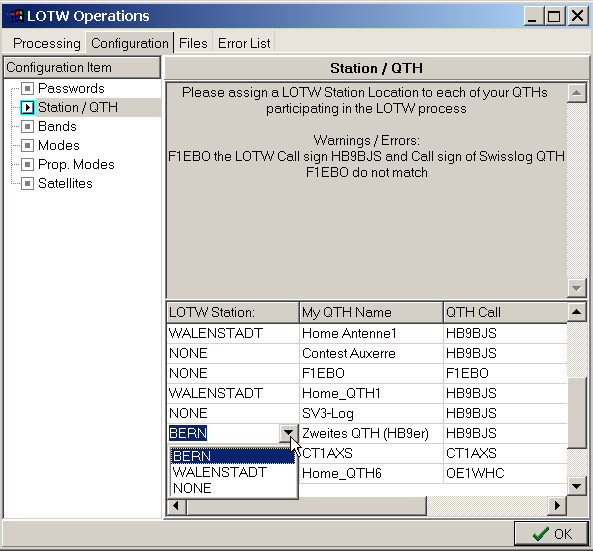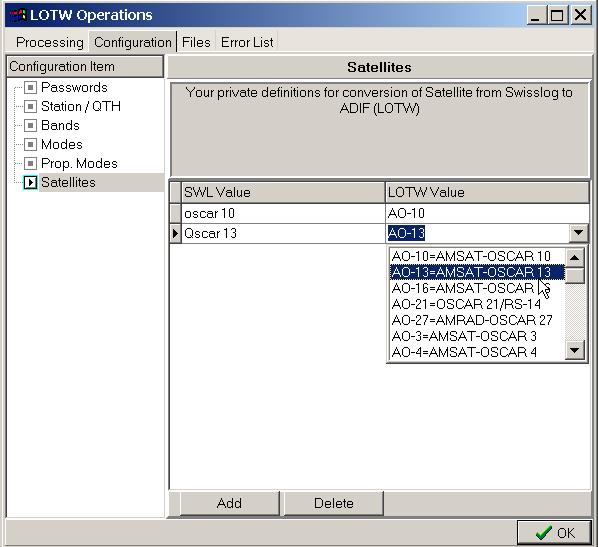
Preparation for LoTW
Before you can use the LoTW functions in SWISSLOG, you will need to install the ARRL LoTW software and request a certificate from the ARRL. Please read the LoTW Page on the Internet for more details.
Briefly stated, the following steps need to be completed before using the LoTW functions:
To configure Swisslog for LoTW you will need to perform the following steps:
To start the configuration of Swisslog select from the main menu:
In the ARRL's LoTW system, the name of the LoTW Station represents the QTH's you are working from. In Swisslog the equivalent data would be the QTH's that are listed as My-QTH's. Therefore, we have to make a link between the LoTW Station and the Swisslog QTH. This is accomplished by putting the name of the LoTW Station into the LoTW Station field that is adjacent to the appropriate Swisslog My-QTH Name field. This may sound confusing now, however it should be clear when you review the dialog window shown below:

The first time the Station / QTH window is opened, you will see list of your QTH's in the center column under the heading My QTH Name. The fields in the first column under the heading LoTW Station will be empty and you will see an error message for each QTH.
Place the cursor in one of the LoTW Station fields in the first column and click with the mouse – an arrow will be displayed. Click on the arrow to open a list containing the names of your LoTW Station Locations. Select the correct one corresponding to the Swisslog My QTH Name. If you do not want to synchronize the QSO's made from a particular QTH with the LoTW select NONE. (Note: the screen image shown above was taken from the development log which contains several QTH's which are not real, that's why there are so many entries defined as NONE).
Hint: When you click on the arrow in the LoTW fields, a list of LoTW Station Locations should appear. If the list is empty, and only the word NONE appears, it means you need to run the ARRL TQSL program. Start the TQSL program and select Station ¦ Add Locations. If this program is not on your computer or you need more information, refer to the ARRL website for help LoTW Page on the Internet.
Error and/or warning message may be displayed in the top part of the dialog window. You can not synchronize the with the LoTW as long as there are error messages.
| Possible error messages: | Corrective action: |
| QTH has no LoTW Station assigned | Assign a LoTW Station Location |
| QTH has non existing LoTW Station assigned | Assign an existing a LoTW Station Location |
| Possible warning messages: | Corrective action: |
| QTH: the LoTW Callsign and Callsign used in the Swisslog QTH do not match | Verify that the Callsign assignment is correct |
In the ARRL's LoTW system, there are several different passwords assigned for distinctly different purposes. Unfortunately this is likely to cause some confusion when your are asked to enter these passwords in different applications. Try to remember the difference between the passwords that are associated with your certificates and the password that you use for logging onto the ARRL LoTW website (which is also different than an ARRL members password for the general ARRL website).
Hint: If you have trouble remembering the password you use for logging onto the LoTW website you can try entering it on the ARRL LoTW website. When you have the correct password, follow the instructions below and enter it in the field next to LoTW Web Password at the bottom of the dialog window.

In the main section of the dialog window there is a list of your Certificate Callsigns and an adjacent field for the corresponding Password. This password is also referred to as the password that protects your private key. If you don't enter the certificate password, Swisslog will prompt you for the password when one is needed.
At the bottom of the window, there are two fields that must be filled in. In the first field next to LoTW Web User Callsign enter the same Callsign that you use to enter the ARRL LoTW website. In the second field next to LoTW Web Password enter the password that you use for logging onto the LoTW website.
LoTW has very strict requirements regarding Band, Mode, Propagation Modes (Prop. Modes), and Satellite names. Swisslog therefore insures, that the correct names are used and converts them as necessary. If Swisslog does not know how to convert one of theses names, it will prompt you for the correct name and store the information in the mapping tables.
Hint: At this point, you don't have to enter any mapping information because Swisslog will ask you when it needs information. Therefore, if you're not sure about the mapping information that might be required, wait until Swisslog prompts you with the pop-up dialog windows. It's also possible you won't need to do any mapping.
If you decide to enter mapping information manually, open the dialog window as shown below:
Important note: The LoTW system defines
the valid names. Therefore, you should only select values from the list. Place
the cursor in one of the LoTW Value fields in the second column and
click with the mouse – an
arrow will be displayed. Click on the arrow to open a list containing the
allowable LoTW Values and select a value.

Copyright © 2004 SWISSLOG
Last modified: 29 ago. 2018